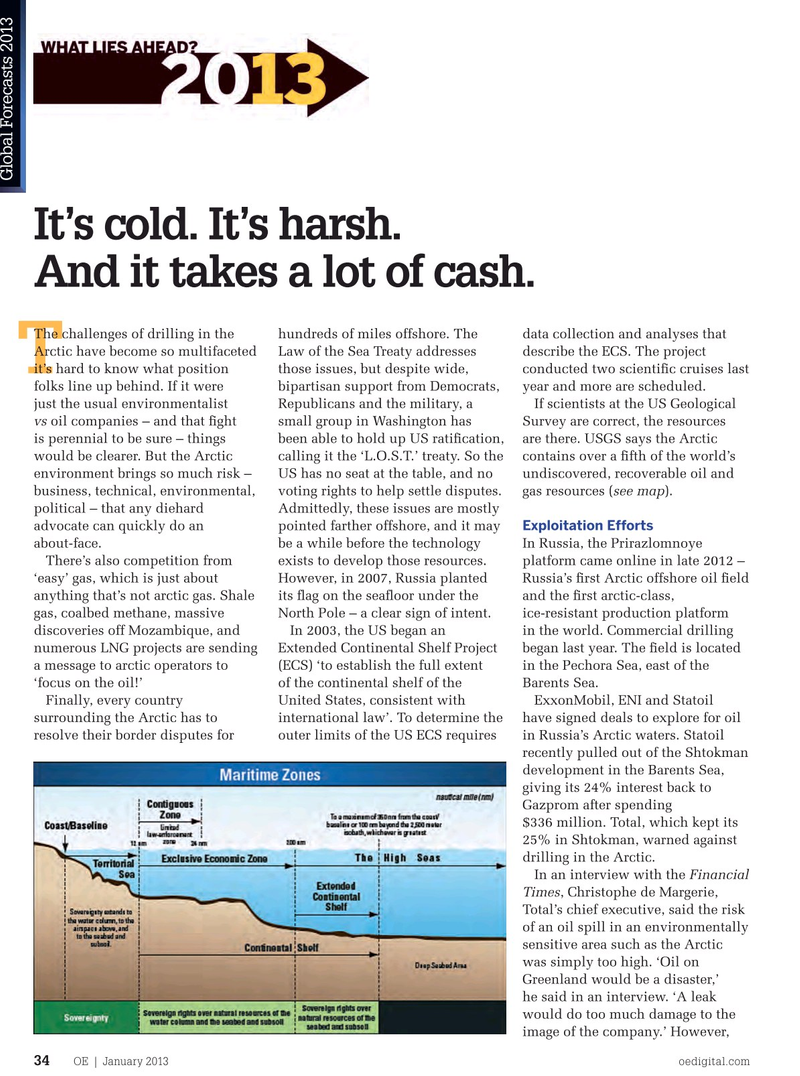
Page 32: of Offshore Engineer Magazine (Jan/Feb 2013)
Read this page in Pdf, Flash or Html5 edition of Jan/Feb 2013 Offshore Engineer Magazine
Global Forecasts 2013
It’s cold. It’s harsh.
And it takes a lot of cash.
The challenges of drilling in the hundreds of miles offshore. The data collection and analyses that
Arctic have become so multifaceted Law of the Sea Treaty addresses describe the ECS. The project it’s hard to know what position those issues, but despite wide, conducted two scienti? c cruises last
T folks line up behind. If it were bipartisan support from Democrats, year and more are scheduled.
just the usual environmentalist Republicans and the military, a If scientists at the US Geological vs oil companies – and that ? ght small group in Washington has Survey are correct, the resources is perennial to be sure – things been able to hold up US rati? cation, are there. USGS says the Arctic would be clearer. But the Arctic calling it the ‘L.O.S.T.’ treaty. So the contains over a ? fth of the world’s environment brings so much risk – US has no seat at the table, and no undiscovered, recoverable oil and business, technical, environmental, voting rights to help settle disputes. gas resources (see map).
political – that any diehard Admittedly, these issues are mostly advocate can quickly do an pointed farther offshore, and it may Exploitation Efforts about-face. be a while before the technology In Russia, the Prirazlomnoye There’s also competition from exists to develop those resources. platform came online in late 2012 – ‘easy’ gas, which is just about However, in 2007, Russia planted Russia’s ? rst Arctic offshore oil ? eld anything that’s not arctic gas. Shale its ? ag on the sea? oor under the and the ? rst arctic-class, gas, coalbed methane, massive North Pole – a clear sign of intent. ice-resistant production platform discoveries off Mozambique, and In 2003, the US began an in the world. Commercial drilling numerous LNG projects are sending Extended Continental Shelf Project began last year. The ? eld is located a message to arctic operators to (ECS) ‘to establish the full extent in the Pechora Sea, east of the ‘focus on the oil!’ of the continental shelf of the Barents Sea. Finally, every country United States, consistent with ExxonMobil, ENI and Statoil surrounding the Arctic has to international law’. To determine the have signed deals to explore for oil resolve their border disputes for outer limits of the US ECS requires in Russia’s Arctic waters. Statoil recently pulled out of the Shtokman development in the Barents Sea, giving its 24% interest back to
Gazprom after spending $336 million. Total, which kept its 25% in Shtokman, warned against drilling in the Arctic.
In an interview with the Financial
Times, Christophe de Margerie,
Total’s chief executive, said the risk of an oil spill in an environmentally sensitive area such as the Arctic was simply too high. ‘Oil on
Greenland would be a disaster,’ he said in an interview. ‘A leak would do too much damage to the image of the company.’ However,
OE | January 2013 oedigital.com 34 oe_forecasts2.indd 34 03/01/2013 13:32

 31
31

 33
33